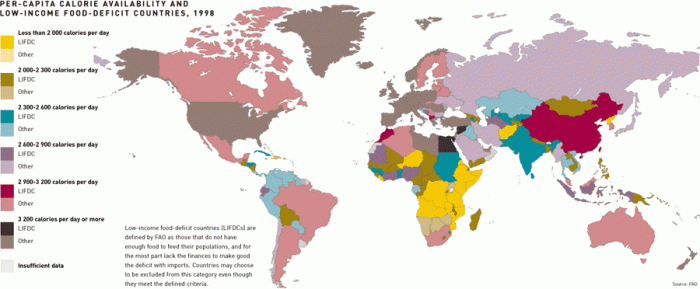14.2.2: Global Overview of Food Insecurity- Food Deficit Map and Required Readings
- Page ID
- 48704
A global overview of food insecurity can be obtained by mapping average daily calorie supply per person for each country (see Figure 11.2.1). Mapped values are shown as ranging from less than 2,000 calories per person (e.g., in Ethiopia and Tanzania) to the range of 2,000-2,500 calories per person, which covers several countries in Africa as well as India and other countries in Asia in addition to Latin America and the Caribbean. Calories are a reasonable way to begin to understand large-scale patterns related to the lack of food access around the world. Nevertheless just looking at calories hides other aspects of human nutrition, such as the need for a diverse diet that satisfies human requirements for vitamins, minerals, and dietary fiber, which were described in module 3.

Figure 11.2.1.: Global Food Insecurity: calorie measures. This map is a good first approximation though it does not address vitamin or micronutrient-based malnutrition, which was described in module 3 of this course. Credit: Atlas of Population and Environment
Required Readings
The following brief readings are good ways to appreciate the analyses and debates surrounding food insecurity and the challenges of "feeding the world", especially in the emerging scenario of climate change impacts on food production. They form part of the required reading for this module and will help you to better understand the materials and the summative assessment.
- Bittman, Mark. "Don't Ask How to Feed the 9 Billion" NYT, Nov 12, 2014./li>
- Deering, K. 2014. Stepping up to the challenge – Six issues facing global climate change and food security, CCAFS (Climate Change and Food Security Program)-UN (United Nations), 2014. Read the page headings on each challenge and the brief description of the response below.


